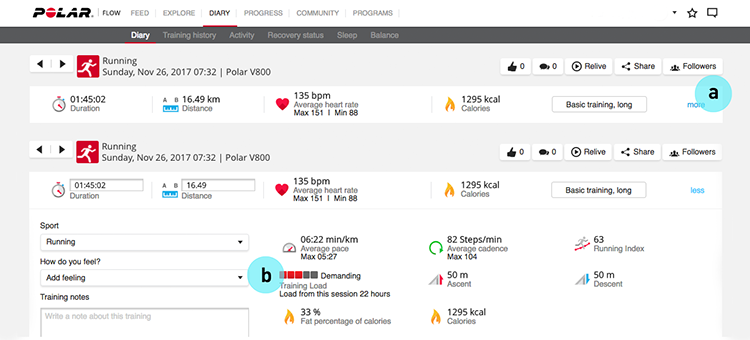The what and how of Training Load

Training load is textual feedback on the strenuousness of a single training session. Training load calculation is based on the consumption of critical energy sources (carbohydrates and proteins) during exercise. The Training Load feature makes the loads of different types of training sessions comparable with each other. For example, you can compare the load of a long low intensity cycling session to that of a short high intensity running session. To enable a more accurate comparison between sessions, we have converted your training load into an approximate recovery need estimation.
When is the Training Load feature most useful?
The calculation is based on heart rate measurement, which is a great way to assess exercise intensity during endurance type of training. Therefore, the Training Load feature is targeted for those whose training mainly includes endurance type of exercise. As heart rate doesn’t fully indicate the muscle fatigue, a sport-specific factor takes into account the type of sport performed.
How do I benefit from the Training Load feature?
The Training Load feature helps you to understand the amount of effort that you put into a training session. Training Load is calculated for every training session based on intensity and duration. The Training Load feature makes the effort of a short high intensity session comparable to that of a long low intensity session. Training Load value is indicated to the user in days and hours for more detailed comparison between sessions.
To improve your performance in the long run, you need to progressively increase the volume and intensity of your training. As your fitness improves, same training session (e.g. 10 km in 1 hour) creates less training load compared to the time when you started to train.
How is Training Load calculated?
Training Load is based on intensity and duration of a training session. The intensity of a session is measured using heart rate and the calculation is further affected by your personal information, such as age, sex, weight, VO2max, and training history. Before training history is available, your Training Background selection is used in the calculation. We also use your aerobic and anaerobic threshold values in the calculation. If you have reliably measured them, please update the default values in the Flow web service. The sport of a session is taken into account via sport specific factor, which improves the calculation accuracy.
Where is Training Load in Polar Flow web service?
Polar Flow shows a description of your Training Load and the corresponding numeric value in days and hours for every training session, if you’re using a Polar training device that supports the Training Load feature.
Go to Diary and click DIARY (a) to see the regular Diary view. The training load for each training session is described with a five-step scale (b). Note that the time above the training load scale is the duration of the training session - not the value for the load from the session. Check the descriptions for each level of the scale below the calendar (c).

Mild 0-6 hours
Reasonable 7-12 hours
Demanding 13-24 hours
Very demanding 25-48 hours
Extreme Over 48 hours
Click a training session in your Diary to open a detailed training analysis view. Expand the view by clicking MORE (a) to check the numeric value for the load from the session (b)

Where is Training Load in the Flow app?


Where is Training Load on my training device?
- M400: You can see the Training Load details from Polar Flow web service.
- M430: You can see the Training Load details from Polar Flow web service.
- M460: You can see the Training Load details from Polar Flow web service.
- V650: You can see the Training Load details from Polar Flow web service.